CHCECE017 Project: Foster Holistic Development and Wellbeing of Child
VerifiedAdded on 2023/06/17
|28
|6668
|149
Project
AI Summary
This CHCECE017 project addresses the skills and knowledge required to foster holistic development and wellbeing in children aged birth to six years. It involves planning a maths learning centre for toddlers, focusing on concepts like color matching, and designing additional small or large group experiences to complement the learning centre. The project details learning goals linked to the Early Years Learning Framework (EYLF), provides a rationale for chosen activities, lists necessary resources, explains the learning centre setup, and identifies key vocabulary to promote children's learning. It also includes plans for assessing the outcomes of these experiences in terms of concept development, aligning with EYLF indicators. This assignment solution, available on Desklib, provides a detailed overview of the project, offering valuable insights for students studying early childhood education and care.
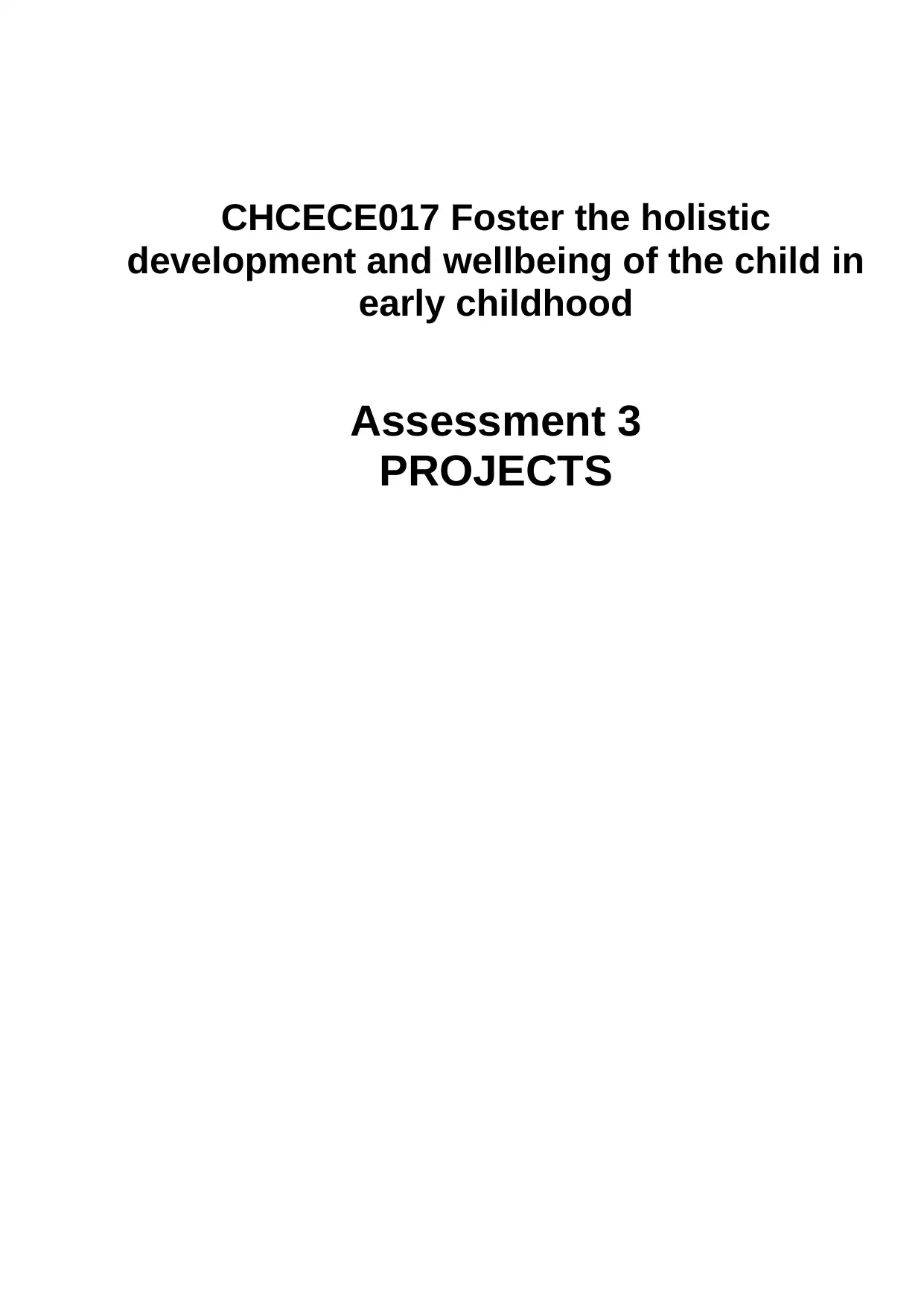
CHCECE017 Foster the holistic
development and wellbeing of the child in
early childhood
Assessment 3
PROJECTS
development and wellbeing of the child in
early childhood
Assessment 3
PROJECTS
Paraphrase This Document
Need a fresh take? Get an instant paraphrase of this document with our AI Paraphraser
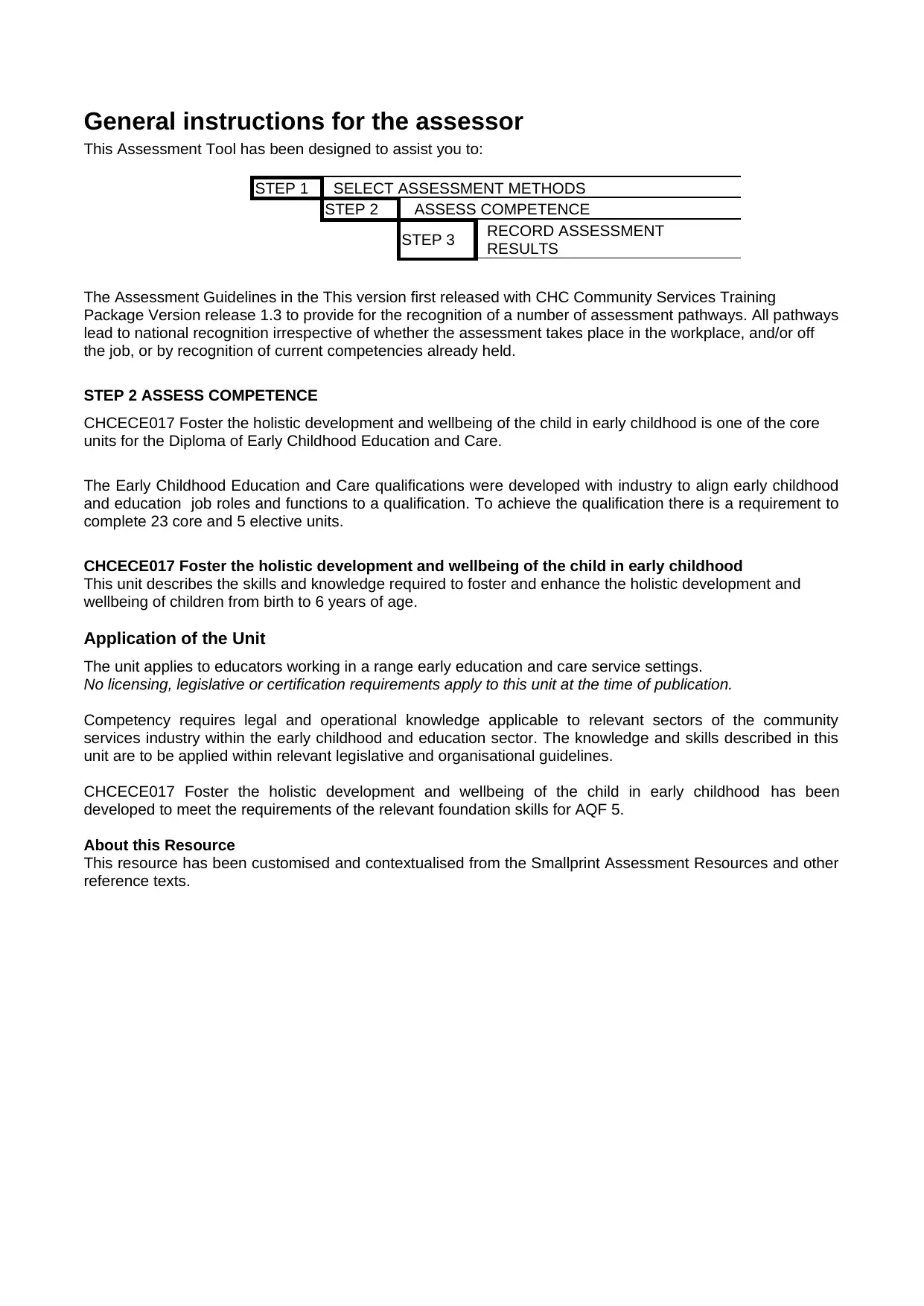
General instructions for the assessor
This Assessment Tool has been designed to assist you to:
STEP 1 SELECT ASSESSMENT METHODS
STEP 2 ASSESS COMPETENCE
STEP 3 RECORD ASSESSMENT
RESULTS
The Assessment Guidelines in the This version first released with CHC Community Services Training
Package Version release 1.3 to provide for the recognition of a number of assessment pathways. All pathways
lead to national recognition irrespective of whether the assessment takes place in the workplace, and/or off
the job, or by recognition of current competencies already held.
STEP 2 ASSESS COMPETENCE
CHCECE017 Foster the holistic development and wellbeing of the child in early childhood is one of the core
units for the Diploma of Early Childhood Education and Care.
The Early Childhood Education and Care qualifications were developed with industry to align early childhood
and education job roles and functions to a qualification. To achieve the qualification there is a requirement to
complete 23 core and 5 elective units.
CHCECE017 Foster the holistic development and wellbeing of the child in early childhood
This unit describes the skills and knowledge required to foster and enhance the holistic development and
wellbeing of children from birth to 6 years of age.
Application of the Unit
The unit applies to educators working in a range early education and care service settings.
No licensing, legislative or certification requirements apply to this unit at the time of publication.
Competency requires legal and operational knowledge applicable to relevant sectors of the community
services industry within the early childhood and education sector. The knowledge and skills described in this
unit are to be applied within relevant legislative and organisational guidelines.
CHCECE017 Foster the holistic development and wellbeing of the child in early childhood has been
developed to meet the requirements of the relevant foundation skills for AQF 5.
About this Resource
This resource has been customised and contextualised from the Smallprint Assessment Resources and other
reference texts.
This Assessment Tool has been designed to assist you to:
STEP 1 SELECT ASSESSMENT METHODS
STEP 2 ASSESS COMPETENCE
STEP 3 RECORD ASSESSMENT
RESULTS
The Assessment Guidelines in the This version first released with CHC Community Services Training
Package Version release 1.3 to provide for the recognition of a number of assessment pathways. All pathways
lead to national recognition irrespective of whether the assessment takes place in the workplace, and/or off
the job, or by recognition of current competencies already held.
STEP 2 ASSESS COMPETENCE
CHCECE017 Foster the holistic development and wellbeing of the child in early childhood is one of the core
units for the Diploma of Early Childhood Education and Care.
The Early Childhood Education and Care qualifications were developed with industry to align early childhood
and education job roles and functions to a qualification. To achieve the qualification there is a requirement to
complete 23 core and 5 elective units.
CHCECE017 Foster the holistic development and wellbeing of the child in early childhood
This unit describes the skills and knowledge required to foster and enhance the holistic development and
wellbeing of children from birth to 6 years of age.
Application of the Unit
The unit applies to educators working in a range early education and care service settings.
No licensing, legislative or certification requirements apply to this unit at the time of publication.
Competency requires legal and operational knowledge applicable to relevant sectors of the community
services industry within the early childhood and education sector. The knowledge and skills described in this
unit are to be applied within relevant legislative and organisational guidelines.
CHCECE017 Foster the holistic development and wellbeing of the child in early childhood has been
developed to meet the requirements of the relevant foundation skills for AQF 5.
About this Resource
This resource has been customised and contextualised from the Smallprint Assessment Resources and other
reference texts.
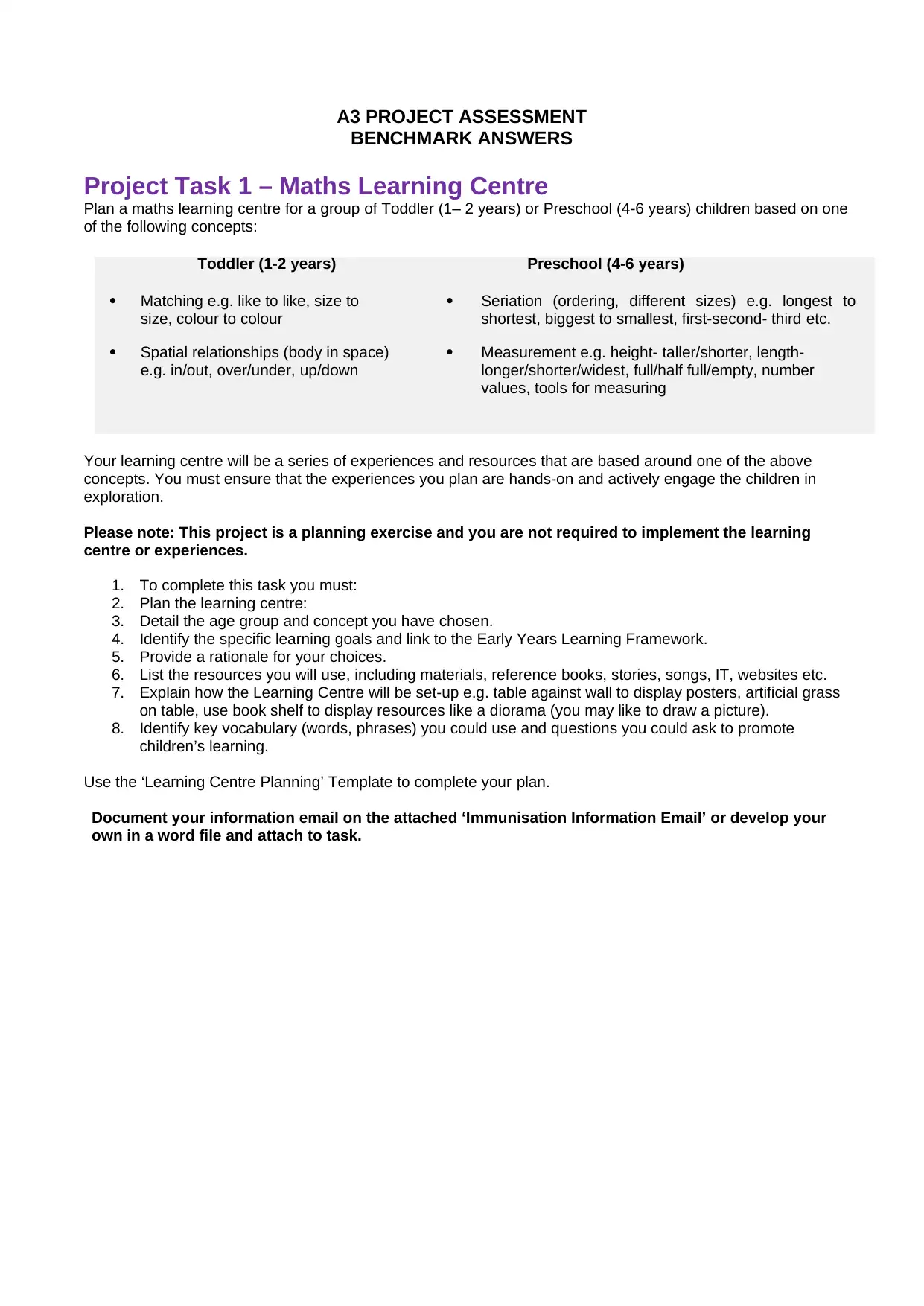
A3 PROJECT ASSESSMENT
BENCHMARK ANSWERS
Project Task 1 – Maths Learning Centre
Plan a maths learning centre for a group of Toddler (1– 2 years) or Preschool (4-6 years) children based on one
of the following concepts:
Toddler (1-2 years) Preschool (4-6 years)
Matching e.g. like to like, size to
size, colour to colour
Spatial relationships (body in space)
e.g. in/out, over/under, up/down
Seriation (ordering, different sizes) e.g. longest to
shortest, biggest to smallest, first-second- third etc.
Measurement e.g. height- taller/shorter, length-
longer/shorter/widest, full/half full/empty, number
values, tools for measuring
Your learning centre will be a series of experiences and resources that are based around one of the above
concepts. You must ensure that the experiences you plan are hands-on and actively engage the children in
exploration.
Please note: This project is a planning exercise and you are not required to implement the learning
centre or experiences.
1. To complete this task you must:
2. Plan the learning centre:
3. Detail the age group and concept you have chosen.
4. Identify the specific learning goals and link to the Early Years Learning Framework.
5. Provide a rationale for your choices.
6. List the resources you will use, including materials, reference books, stories, songs, IT, websites etc.
7. Explain how the Learning Centre will be set-up e.g. table against wall to display posters, artificial grass
on table, use book shelf to display resources like a diorama (you may like to draw a picture).
8. Identify key vocabulary (words, phrases) you could use and questions you could ask to promote
children’s learning.
Use the ‘Learning Centre Planning’ Template to complete your plan.
Document your information email on the attached ‘Immunisation Information Email’ or develop your
own in a word file and attach to task.
BENCHMARK ANSWERS
Project Task 1 – Maths Learning Centre
Plan a maths learning centre for a group of Toddler (1– 2 years) or Preschool (4-6 years) children based on one
of the following concepts:
Toddler (1-2 years) Preschool (4-6 years)
Matching e.g. like to like, size to
size, colour to colour
Spatial relationships (body in space)
e.g. in/out, over/under, up/down
Seriation (ordering, different sizes) e.g. longest to
shortest, biggest to smallest, first-second- third etc.
Measurement e.g. height- taller/shorter, length-
longer/shorter/widest, full/half full/empty, number
values, tools for measuring
Your learning centre will be a series of experiences and resources that are based around one of the above
concepts. You must ensure that the experiences you plan are hands-on and actively engage the children in
exploration.
Please note: This project is a planning exercise and you are not required to implement the learning
centre or experiences.
1. To complete this task you must:
2. Plan the learning centre:
3. Detail the age group and concept you have chosen.
4. Identify the specific learning goals and link to the Early Years Learning Framework.
5. Provide a rationale for your choices.
6. List the resources you will use, including materials, reference books, stories, songs, IT, websites etc.
7. Explain how the Learning Centre will be set-up e.g. table against wall to display posters, artificial grass
on table, use book shelf to display resources like a diorama (you may like to draw a picture).
8. Identify key vocabulary (words, phrases) you could use and questions you could ask to promote
children’s learning.
Use the ‘Learning Centre Planning’ Template to complete your plan.
Document your information email on the attached ‘Immunisation Information Email’ or develop your
own in a word file and attach to task.
⊘ This is a preview!⊘
Do you want full access?
Subscribe today to unlock all pages.

Trusted by 1+ million students worldwide
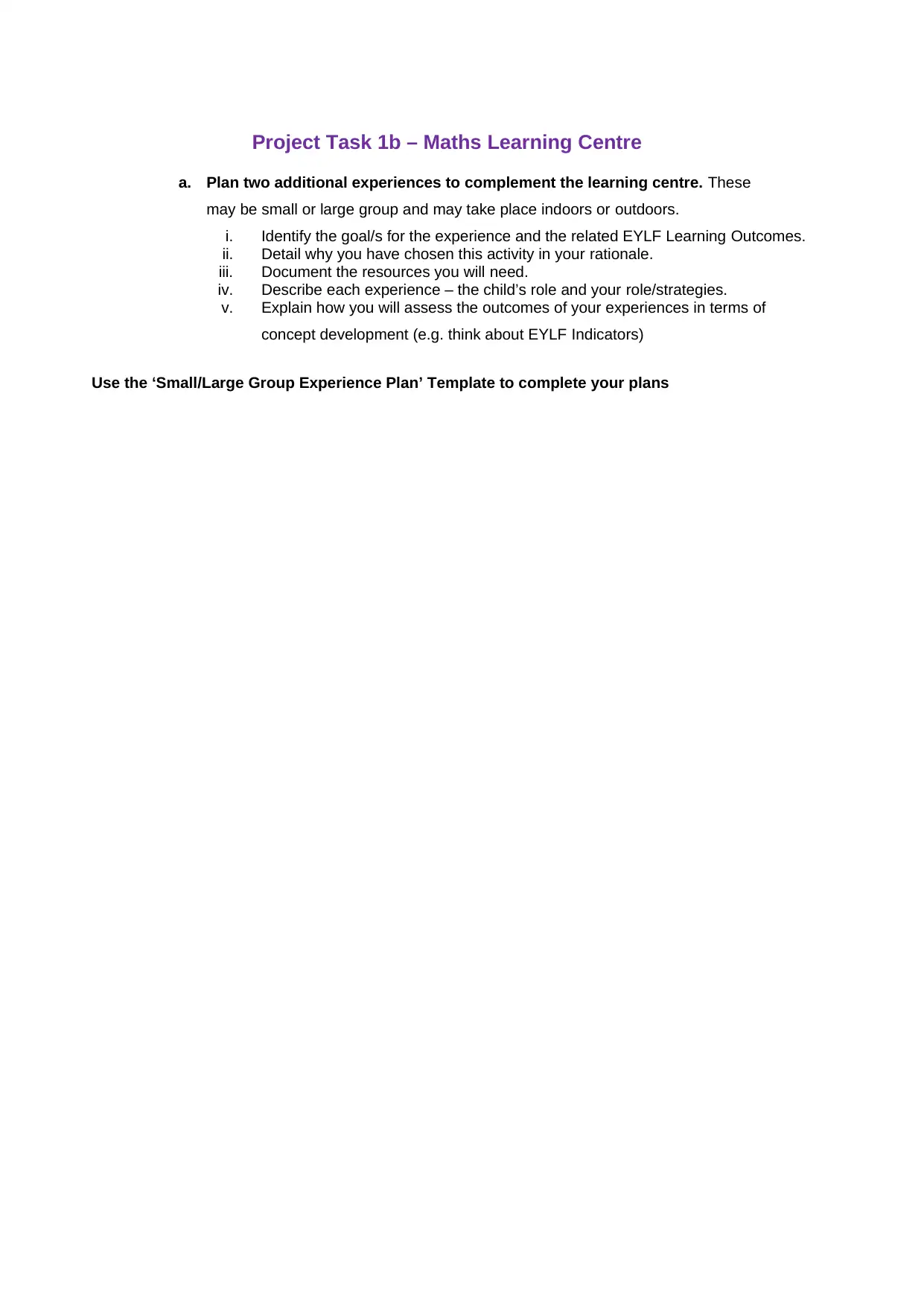
Project Task 1b – Maths Learning Centre
a. Plan two additional experiences to complement the learning centre. These
may be small or large group and may take place indoors or outdoors.
i. Identify the goal/s for the experience and the related EYLF Learning Outcomes.
ii. Detail why you have chosen this activity in your rationale.
iii. Document the resources you will need.
iv. Describe each experience – the child’s role and your role/strategies.
v. Explain how you will assess the outcomes of your experiences in terms of
concept development (e.g. think about EYLF Indicators)
Use the ‘Small/Large Group Experience Plan’ Template to complete your plans
a. Plan two additional experiences to complement the learning centre. These
may be small or large group and may take place indoors or outdoors.
i. Identify the goal/s for the experience and the related EYLF Learning Outcomes.
ii. Detail why you have chosen this activity in your rationale.
iii. Document the resources you will need.
iv. Describe each experience – the child’s role and your role/strategies.
v. Explain how you will assess the outcomes of your experiences in terms of
concept development (e.g. think about EYLF Indicators)
Use the ‘Small/Large Group Experience Plan’ Template to complete your plans
Paraphrase This Document
Need a fresh take? Get an instant paraphrase of this document with our AI Paraphraser
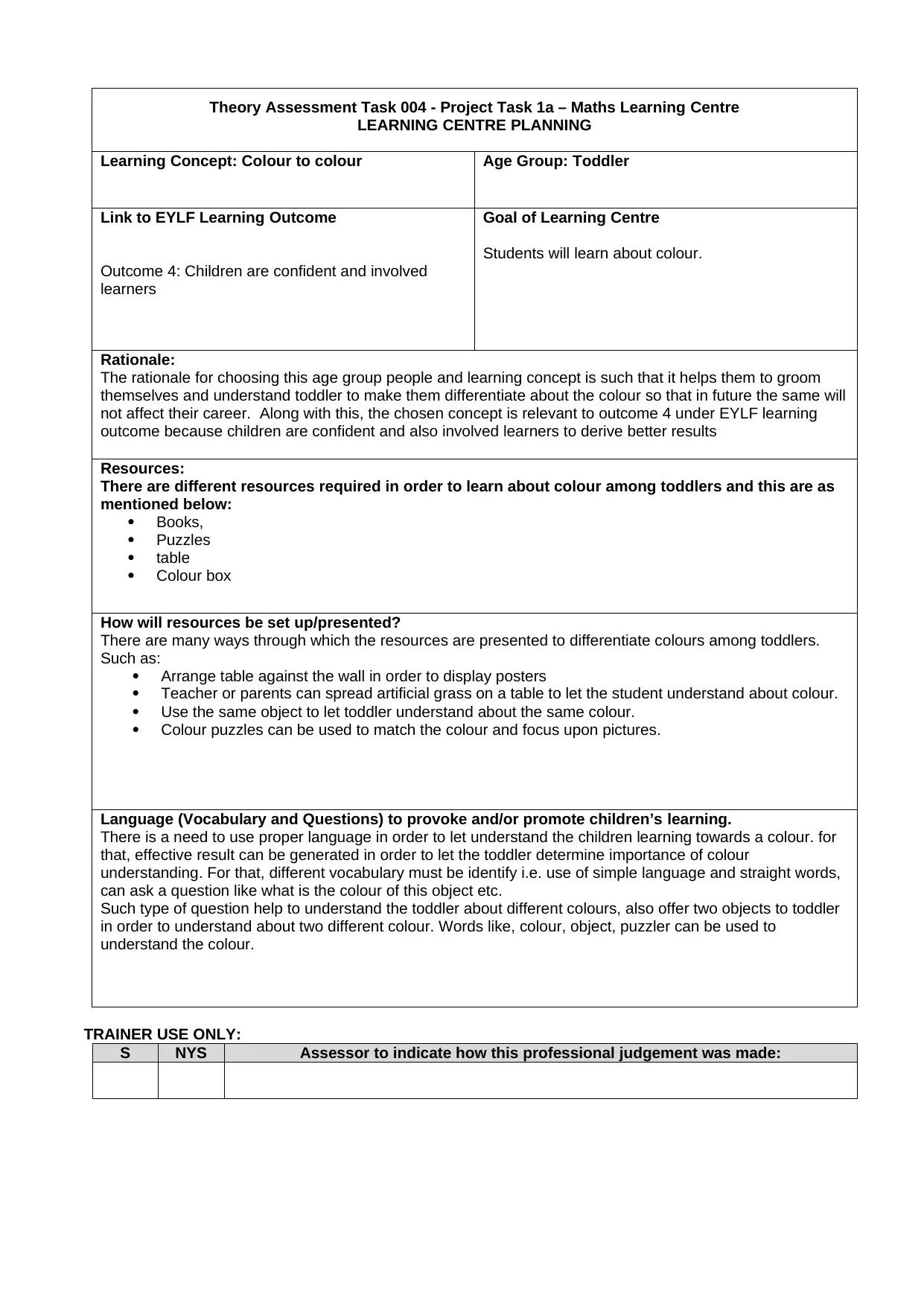
Theory Assessment Task 004 - Project Task 1a – Maths Learning Centre
LEARNING CENTRE PLANNING
Learning Concept: Colour to colour Age Group: Toddler
Link to EYLF Learning Outcome
Outcome 4: Children are confident and involved
learners
Goal of Learning Centre
Students will learn about colour.
Rationale:
The rationale for choosing this age group people and learning concept is such that it helps them to groom
themselves and understand toddler to make them differentiate about the colour so that in future the same will
not affect their career. Along with this, the chosen concept is relevant to outcome 4 under EYLF learning
outcome because children are confident and also involved learners to derive better results
Resources:
There are different resources required in order to learn about colour among toddlers and this are as
mentioned below:
Books,
Puzzles
table
Colour box
How will resources be set up/presented?
There are many ways through which the resources are presented to differentiate colours among toddlers.
Such as:
Arrange table against the wall in order to display posters
Teacher or parents can spread artificial grass on a table to let the student understand about colour.
Use the same object to let toddler understand about the same colour.
Colour puzzles can be used to match the colour and focus upon pictures.
Language (Vocabulary and Questions) to provoke and/or promote children’s learning.
There is a need to use proper language in order to let understand the children learning towards a colour. for
that, effective result can be generated in order to let the toddler determine importance of colour
understanding. For that, different vocabulary must be identify i.e. use of simple language and straight words,
can ask a question like what is the colour of this object etc.
Such type of question help to understand the toddler about different colours, also offer two objects to toddler
in order to understand about two different colour. Words like, colour, object, puzzler can be used to
understand the colour.
TRAINER USE ONLY:
S NYS Assessor to indicate how this professional judgement was made:
LEARNING CENTRE PLANNING
Learning Concept: Colour to colour Age Group: Toddler
Link to EYLF Learning Outcome
Outcome 4: Children are confident and involved
learners
Goal of Learning Centre
Students will learn about colour.
Rationale:
The rationale for choosing this age group people and learning concept is such that it helps them to groom
themselves and understand toddler to make them differentiate about the colour so that in future the same will
not affect their career. Along with this, the chosen concept is relevant to outcome 4 under EYLF learning
outcome because children are confident and also involved learners to derive better results
Resources:
There are different resources required in order to learn about colour among toddlers and this are as
mentioned below:
Books,
Puzzles
table
Colour box
How will resources be set up/presented?
There are many ways through which the resources are presented to differentiate colours among toddlers.
Such as:
Arrange table against the wall in order to display posters
Teacher or parents can spread artificial grass on a table to let the student understand about colour.
Use the same object to let toddler understand about the same colour.
Colour puzzles can be used to match the colour and focus upon pictures.
Language (Vocabulary and Questions) to provoke and/or promote children’s learning.
There is a need to use proper language in order to let understand the children learning towards a colour. for
that, effective result can be generated in order to let the toddler determine importance of colour
understanding. For that, different vocabulary must be identify i.e. use of simple language and straight words,
can ask a question like what is the colour of this object etc.
Such type of question help to understand the toddler about different colours, also offer two objects to toddler
in order to understand about two different colour. Words like, colour, object, puzzler can be used to
understand the colour.
TRAINER USE ONLY:
S NYS Assessor to indicate how this professional judgement was made:
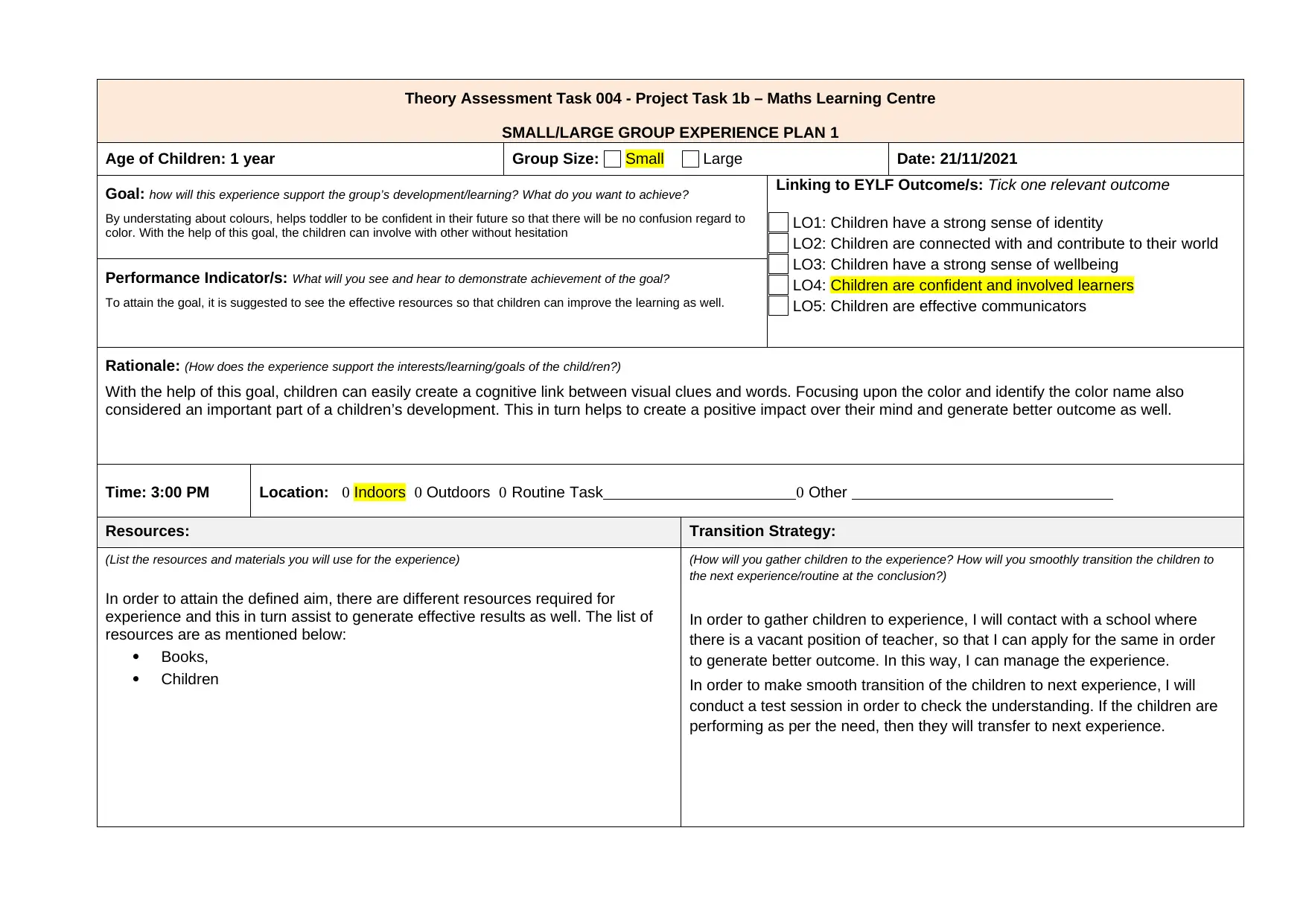
Theory Assessment Task 004 - Project Task 1b – Maths Learning Centre
SMALL/LARGE GROUP EXPERIENCE PLAN 1
Age of Children: 1 year Group Size: Small Large Date: 21/11/2021
Goal: how will this experience support the group’s development/learning? What do you want to achieve?
By understating about colours, helps toddler to be confident in their future so that there will be no confusion regard to
color. With the help of this goal, the children can involve with other without hesitation
Linking to EYLF Outcome/s: Tick one relevant outcome
LO1: Children have a strong sense of identity
LO2: Children are connected with and contribute to their world
LO3: Children have a strong sense of wellbeing
LO4: Children are confident and involved learners
LO5: Children are effective communicators
Performance Indicator/s: What will you see and hear to demonstrate achievement of the goal?
To attain the goal, it is suggested to see the effective resources so that children can improve the learning as well.
Rationale: (How does the experience support the interests/learning/goals of the child/ren?)
With the help of this goal, children can easily create a cognitive link between visual clues and words. Focusing upon the color and identify the color name also
considered an important part of a children’s development. This in turn helps to create a positive impact over their mind and generate better outcome as well.
Time: 3:00 PM Location: Indoors Outdoors Routine Task Other
Resources: Transition Strategy:
(List the resources and materials you will use for the experience)
In order to attain the defined aim, there are different resources required for
experience and this in turn assist to generate effective results as well. The list of
resources are as mentioned below:
Books,
Children
(How will you gather children to the experience? How will you smoothly transition the children to
the next experience/routine at the conclusion?)
In order to gather children to experience, I will contact with a school where
there is a vacant position of teacher, so that I can apply for the same in order
to generate better outcome. In this way, I can manage the experience.
In order to make smooth transition of the children to next experience, I will
conduct a test session in order to check the understanding. If the children are
performing as per the need, then they will transfer to next experience.
SMALL/LARGE GROUP EXPERIENCE PLAN 1
Age of Children: 1 year Group Size: Small Large Date: 21/11/2021
Goal: how will this experience support the group’s development/learning? What do you want to achieve?
By understating about colours, helps toddler to be confident in their future so that there will be no confusion regard to
color. With the help of this goal, the children can involve with other without hesitation
Linking to EYLF Outcome/s: Tick one relevant outcome
LO1: Children have a strong sense of identity
LO2: Children are connected with and contribute to their world
LO3: Children have a strong sense of wellbeing
LO4: Children are confident and involved learners
LO5: Children are effective communicators
Performance Indicator/s: What will you see and hear to demonstrate achievement of the goal?
To attain the goal, it is suggested to see the effective resources so that children can improve the learning as well.
Rationale: (How does the experience support the interests/learning/goals of the child/ren?)
With the help of this goal, children can easily create a cognitive link between visual clues and words. Focusing upon the color and identify the color name also
considered an important part of a children’s development. This in turn helps to create a positive impact over their mind and generate better outcome as well.
Time: 3:00 PM Location: Indoors Outdoors Routine Task Other
Resources: Transition Strategy:
(List the resources and materials you will use for the experience)
In order to attain the defined aim, there are different resources required for
experience and this in turn assist to generate effective results as well. The list of
resources are as mentioned below:
Books,
Children
(How will you gather children to the experience? How will you smoothly transition the children to
the next experience/routine at the conclusion?)
In order to gather children to experience, I will contact with a school where
there is a vacant position of teacher, so that I can apply for the same in order
to generate better outcome. In this way, I can manage the experience.
In order to make smooth transition of the children to next experience, I will
conduct a test session in order to check the understanding. If the children are
performing as per the need, then they will transfer to next experience.
⊘ This is a preview!⊘
Do you want full access?
Subscribe today to unlock all pages.

Trusted by 1+ million students worldwide
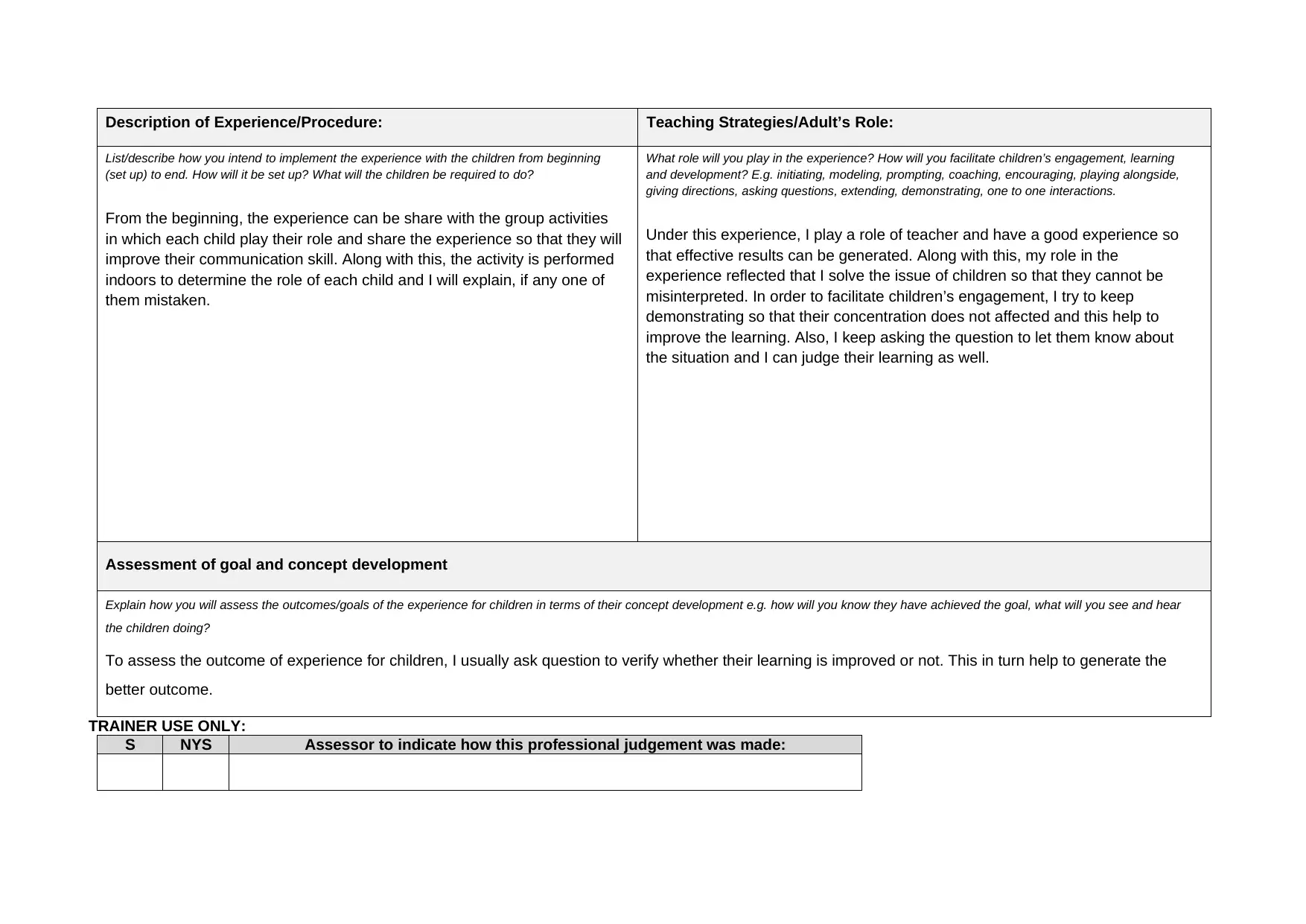
Description of Experience/Procedure: Teaching Strategies/Adult’s Role:
List/describe how you intend to implement the experience with the children from beginning
(set up) to end. How will it be set up? What will the children be required to do?
From the beginning, the experience can be share with the group activities
in which each child play their role and share the experience so that they will
improve their communication skill. Along with this, the activity is performed
indoors to determine the role of each child and I will explain, if any one of
them mistaken.
What role will you play in the experience? How will you facilitate children’s engagement, learning
and development? E.g. initiating, modeling, prompting, coaching, encouraging, playing alongside,
giving directions, asking questions, extending, demonstrating, one to one interactions.
Under this experience, I play a role of teacher and have a good experience so
that effective results can be generated. Along with this, my role in the
experience reflected that I solve the issue of children so that they cannot be
misinterpreted. In order to facilitate children’s engagement, I try to keep
demonstrating so that their concentration does not affected and this help to
improve the learning. Also, I keep asking the question to let them know about
the situation and I can judge their learning as well.
Assessment of goal and concept development
Explain how you will assess the outcomes/goals of the experience for children in terms of their concept development e.g. how will you know they have achieved the goal, what will you see and hear
the children doing?
To assess the outcome of experience for children, I usually ask question to verify whether their learning is improved or not. This in turn help to generate the
better outcome.
TRAINER USE ONLY:
S NYS Assessor to indicate how this professional judgement was made:
List/describe how you intend to implement the experience with the children from beginning
(set up) to end. How will it be set up? What will the children be required to do?
From the beginning, the experience can be share with the group activities
in which each child play their role and share the experience so that they will
improve their communication skill. Along with this, the activity is performed
indoors to determine the role of each child and I will explain, if any one of
them mistaken.
What role will you play in the experience? How will you facilitate children’s engagement, learning
and development? E.g. initiating, modeling, prompting, coaching, encouraging, playing alongside,
giving directions, asking questions, extending, demonstrating, one to one interactions.
Under this experience, I play a role of teacher and have a good experience so
that effective results can be generated. Along with this, my role in the
experience reflected that I solve the issue of children so that they cannot be
misinterpreted. In order to facilitate children’s engagement, I try to keep
demonstrating so that their concentration does not affected and this help to
improve the learning. Also, I keep asking the question to let them know about
the situation and I can judge their learning as well.
Assessment of goal and concept development
Explain how you will assess the outcomes/goals of the experience for children in terms of their concept development e.g. how will you know they have achieved the goal, what will you see and hear
the children doing?
To assess the outcome of experience for children, I usually ask question to verify whether their learning is improved or not. This in turn help to generate the
better outcome.
TRAINER USE ONLY:
S NYS Assessor to indicate how this professional judgement was made:
Paraphrase This Document
Need a fresh take? Get an instant paraphrase of this document with our AI Paraphraser
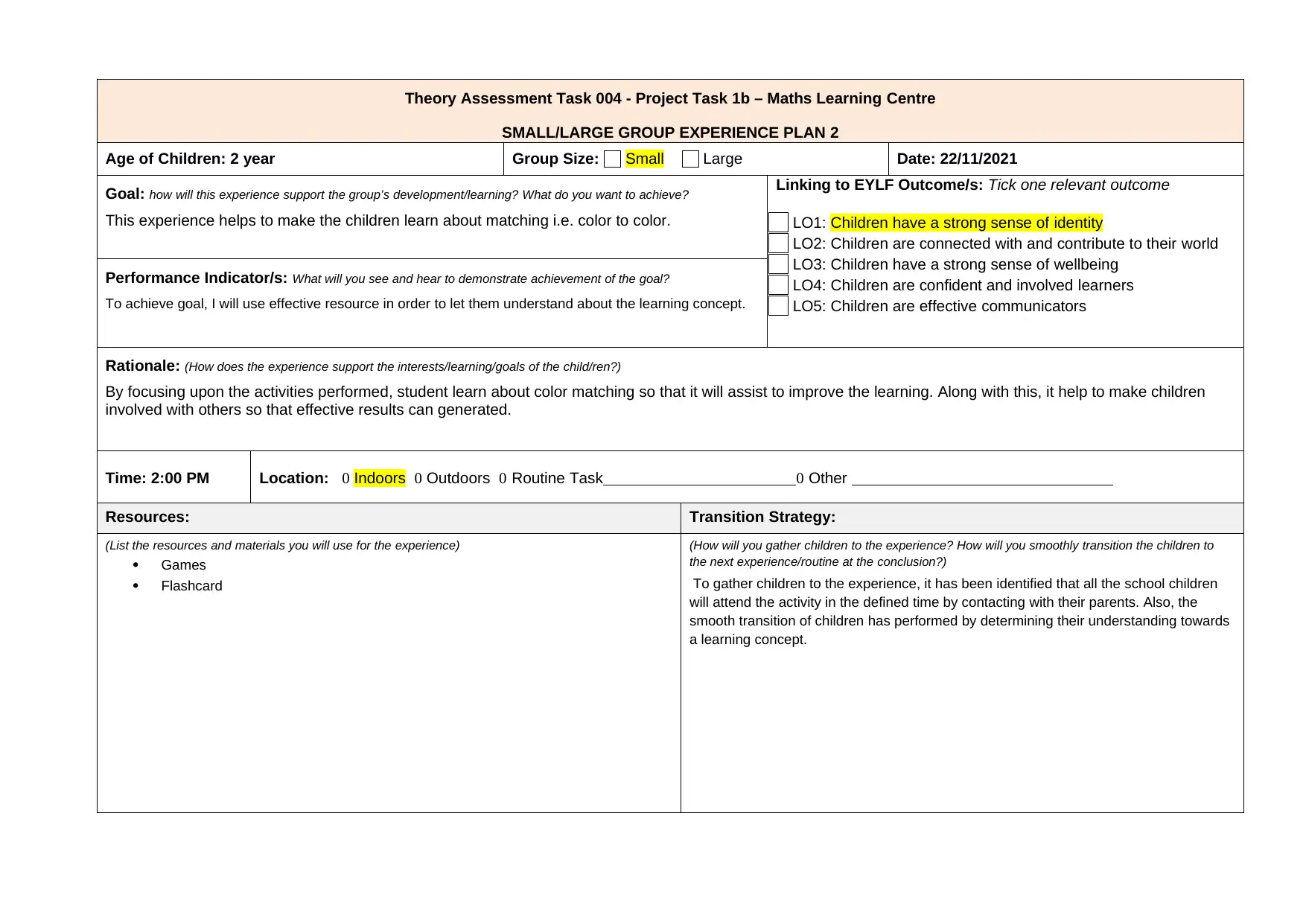
Theory Assessment Task 004 - Project Task 1b – Maths Learning Centre
SMALL/LARGE GROUP EXPERIENCE PLAN 2
Age of Children: 2 year Group Size: Small Large Date: 22/11/2021
Goal: how will this experience support the group’s development/learning? What do you want to achieve?
This experience helps to make the children learn about matching i.e. color to color.
Linking to EYLF Outcome/s: Tick one relevant outcome
LO1: Children have a strong sense of identity
LO2: Children are connected with and contribute to their world
LO3: Children have a strong sense of wellbeing
LO4: Children are confident and involved learners
LO5: Children are effective communicators
Performance Indicator/s: What will you see and hear to demonstrate achievement of the goal?
To achieve goal, I will use effective resource in order to let them understand about the learning concept.
Rationale: (How does the experience support the interests/learning/goals of the child/ren?)
By focusing upon the activities performed, student learn about color matching so that it will assist to improve the learning. Along with this, it help to make children
involved with others so that effective results can generated.
Time: 2:00 PM Location: Indoors Outdoors Routine Task Other
Resources: Transition Strategy:
(List the resources and materials you will use for the experience)
Games
Flashcard
(How will you gather children to the experience? How will you smoothly transition the children to
the next experience/routine at the conclusion?)
To gather children to the experience, it has been identified that all the school children
will attend the activity in the defined time by contacting with their parents. Also, the
smooth transition of children has performed by determining their understanding towards
a learning concept.
SMALL/LARGE GROUP EXPERIENCE PLAN 2
Age of Children: 2 year Group Size: Small Large Date: 22/11/2021
Goal: how will this experience support the group’s development/learning? What do you want to achieve?
This experience helps to make the children learn about matching i.e. color to color.
Linking to EYLF Outcome/s: Tick one relevant outcome
LO1: Children have a strong sense of identity
LO2: Children are connected with and contribute to their world
LO3: Children have a strong sense of wellbeing
LO4: Children are confident and involved learners
LO5: Children are effective communicators
Performance Indicator/s: What will you see and hear to demonstrate achievement of the goal?
To achieve goal, I will use effective resource in order to let them understand about the learning concept.
Rationale: (How does the experience support the interests/learning/goals of the child/ren?)
By focusing upon the activities performed, student learn about color matching so that it will assist to improve the learning. Along with this, it help to make children
involved with others so that effective results can generated.
Time: 2:00 PM Location: Indoors Outdoors Routine Task Other
Resources: Transition Strategy:
(List the resources and materials you will use for the experience)
Games
Flashcard
(How will you gather children to the experience? How will you smoothly transition the children to
the next experience/routine at the conclusion?)
To gather children to the experience, it has been identified that all the school children
will attend the activity in the defined time by contacting with their parents. Also, the
smooth transition of children has performed by determining their understanding towards
a learning concept.
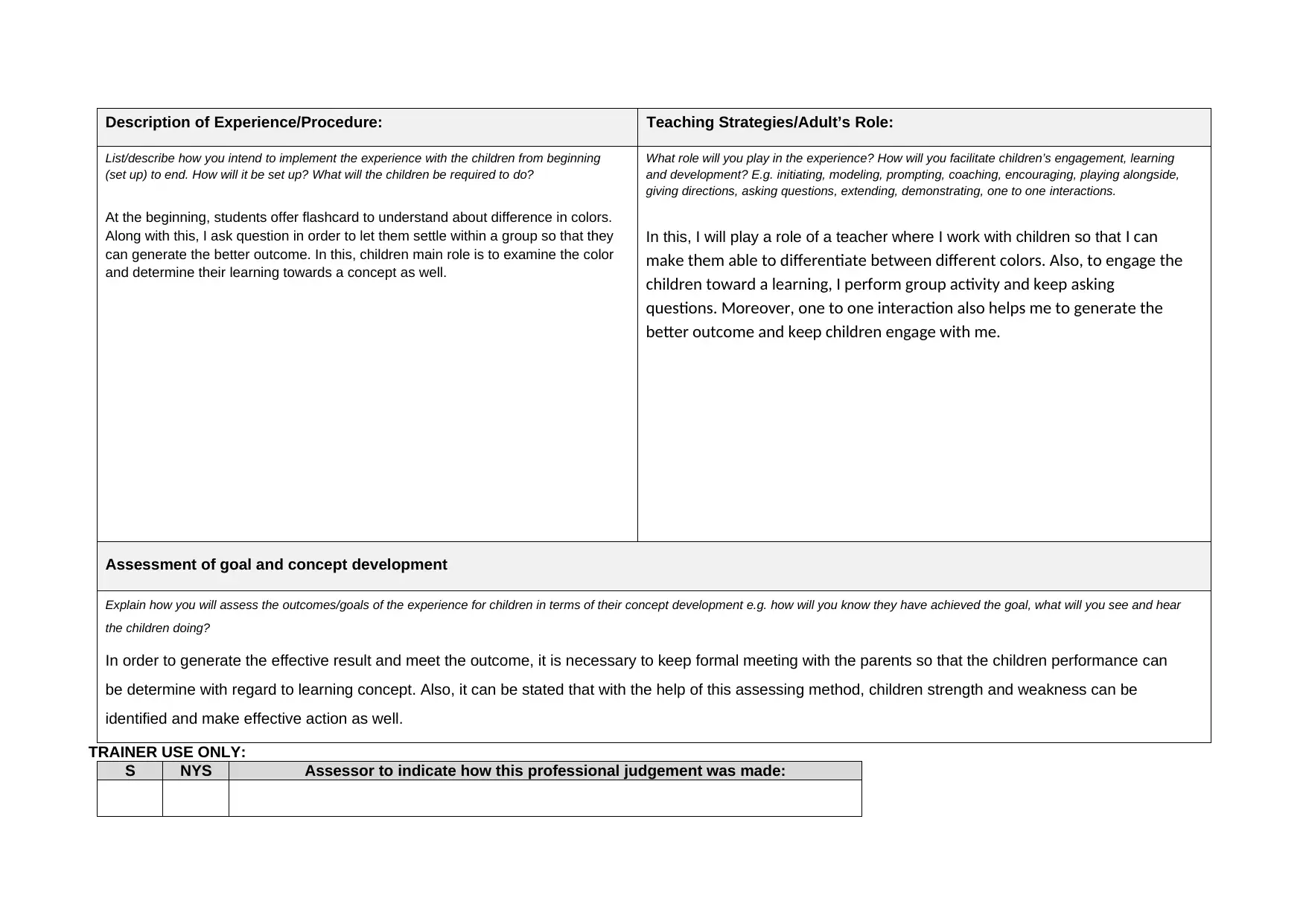
Description of Experience/Procedure: Teaching Strategies/Adult’s Role:
List/describe how you intend to implement the experience with the children from beginning
(set up) to end. How will it be set up? What will the children be required to do?
At the beginning, students offer flashcard to understand about difference in colors.
Along with this, I ask question in order to let them settle within a group so that they
can generate the better outcome. In this, children main role is to examine the color
and determine their learning towards a concept as well.
What role will you play in the experience? How will you facilitate children’s engagement, learning
and development? E.g. initiating, modeling, prompting, coaching, encouraging, playing alongside,
giving directions, asking questions, extending, demonstrating, one to one interactions.
In this, I will play a role of a teacher where I work with children so that I can
make them able to differentiate between different colors. Also, to engage the
children toward a learning, I perform group activity and keep asking
questions. Moreover, one to one interaction also helps me to generate the
better outcome and keep children engage with me.
Assessment of goal and concept development
Explain how you will assess the outcomes/goals of the experience for children in terms of their concept development e.g. how will you know they have achieved the goal, what will you see and hear
the children doing?
In order to generate the effective result and meet the outcome, it is necessary to keep formal meeting with the parents so that the children performance can
be determine with regard to learning concept. Also, it can be stated that with the help of this assessing method, children strength and weakness can be
identified and make effective action as well.
TRAINER USE ONLY:
S NYS Assessor to indicate how this professional judgement was made:
List/describe how you intend to implement the experience with the children from beginning
(set up) to end. How will it be set up? What will the children be required to do?
At the beginning, students offer flashcard to understand about difference in colors.
Along with this, I ask question in order to let them settle within a group so that they
can generate the better outcome. In this, children main role is to examine the color
and determine their learning towards a concept as well.
What role will you play in the experience? How will you facilitate children’s engagement, learning
and development? E.g. initiating, modeling, prompting, coaching, encouraging, playing alongside,
giving directions, asking questions, extending, demonstrating, one to one interactions.
In this, I will play a role of a teacher where I work with children so that I can
make them able to differentiate between different colors. Also, to engage the
children toward a learning, I perform group activity and keep asking
questions. Moreover, one to one interaction also helps me to generate the
better outcome and keep children engage with me.
Assessment of goal and concept development
Explain how you will assess the outcomes/goals of the experience for children in terms of their concept development e.g. how will you know they have achieved the goal, what will you see and hear
the children doing?
In order to generate the effective result and meet the outcome, it is necessary to keep formal meeting with the parents so that the children performance can
be determine with regard to learning concept. Also, it can be stated that with the help of this assessing method, children strength and weakness can be
identified and make effective action as well.
TRAINER USE ONLY:
S NYS Assessor to indicate how this professional judgement was made:
⊘ This is a preview!⊘
Do you want full access?
Subscribe today to unlock all pages.

Trusted by 1+ million students worldwide

Paraphrase This Document
Need a fresh take? Get an instant paraphrase of this document with our AI Paraphraser
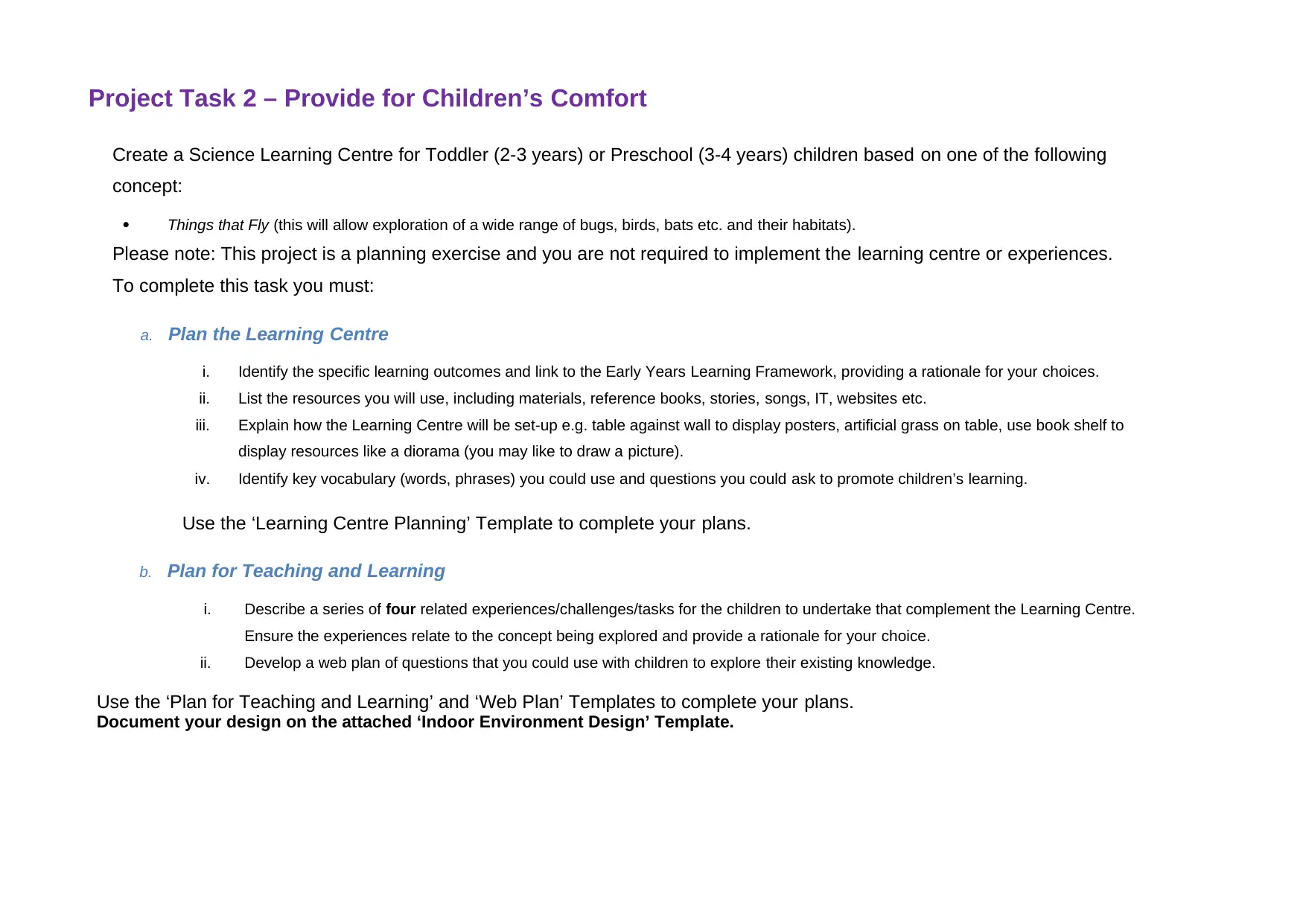
Project Task 2 – Provide for Children’s Comfort
Create a Science Learning Centre for Toddler (2-3 years) or Preschool (3-4 years) children based on one of the following
concept:
Things that Fly (this will allow exploration of a wide range of bugs, birds, bats etc. and their habitats).
Please note: This project is a planning exercise and you are not required to implement the learning centre or experiences.
To complete this task you must:
a. Plan the Learning Centre
i. Identify the specific learning outcomes and link to the Early Years Learning Framework, providing a rationale for your choices.
ii. List the resources you will use, including materials, reference books, stories, songs, IT, websites etc.
iii. Explain how the Learning Centre will be set-up e.g. table against wall to display posters, artificial grass on table, use book shelf to
display resources like a diorama (you may like to draw a picture).
iv. Identify key vocabulary (words, phrases) you could use and questions you could ask to promote children’s learning.
Use the ‘Learning Centre Planning’ Template to complete your plans.
b. Plan for Teaching and Learning
i. Describe a series of four related experiences/challenges/tasks for the children to undertake that complement the Learning Centre.
Ensure the experiences relate to the concept being explored and provide a rationale for your choice.
ii. Develop a web plan of questions that you could use with children to explore their existing knowledge.
Use the ‘Plan for Teaching and Learning’ and ‘Web Plan’ Templates to complete your plans.
Document your design on the attached ‘Indoor Environment Design’ Template.
Create a Science Learning Centre for Toddler (2-3 years) or Preschool (3-4 years) children based on one of the following
concept:
Things that Fly (this will allow exploration of a wide range of bugs, birds, bats etc. and their habitats).
Please note: This project is a planning exercise and you are not required to implement the learning centre or experiences.
To complete this task you must:
a. Plan the Learning Centre
i. Identify the specific learning outcomes and link to the Early Years Learning Framework, providing a rationale for your choices.
ii. List the resources you will use, including materials, reference books, stories, songs, IT, websites etc.
iii. Explain how the Learning Centre will be set-up e.g. table against wall to display posters, artificial grass on table, use book shelf to
display resources like a diorama (you may like to draw a picture).
iv. Identify key vocabulary (words, phrases) you could use and questions you could ask to promote children’s learning.
Use the ‘Learning Centre Planning’ Template to complete your plans.
b. Plan for Teaching and Learning
i. Describe a series of four related experiences/challenges/tasks for the children to undertake that complement the Learning Centre.
Ensure the experiences relate to the concept being explored and provide a rationale for your choice.
ii. Develop a web plan of questions that you could use with children to explore their existing knowledge.
Use the ‘Plan for Teaching and Learning’ and ‘Web Plan’ Templates to complete your plans.
Document your design on the attached ‘Indoor Environment Design’ Template.
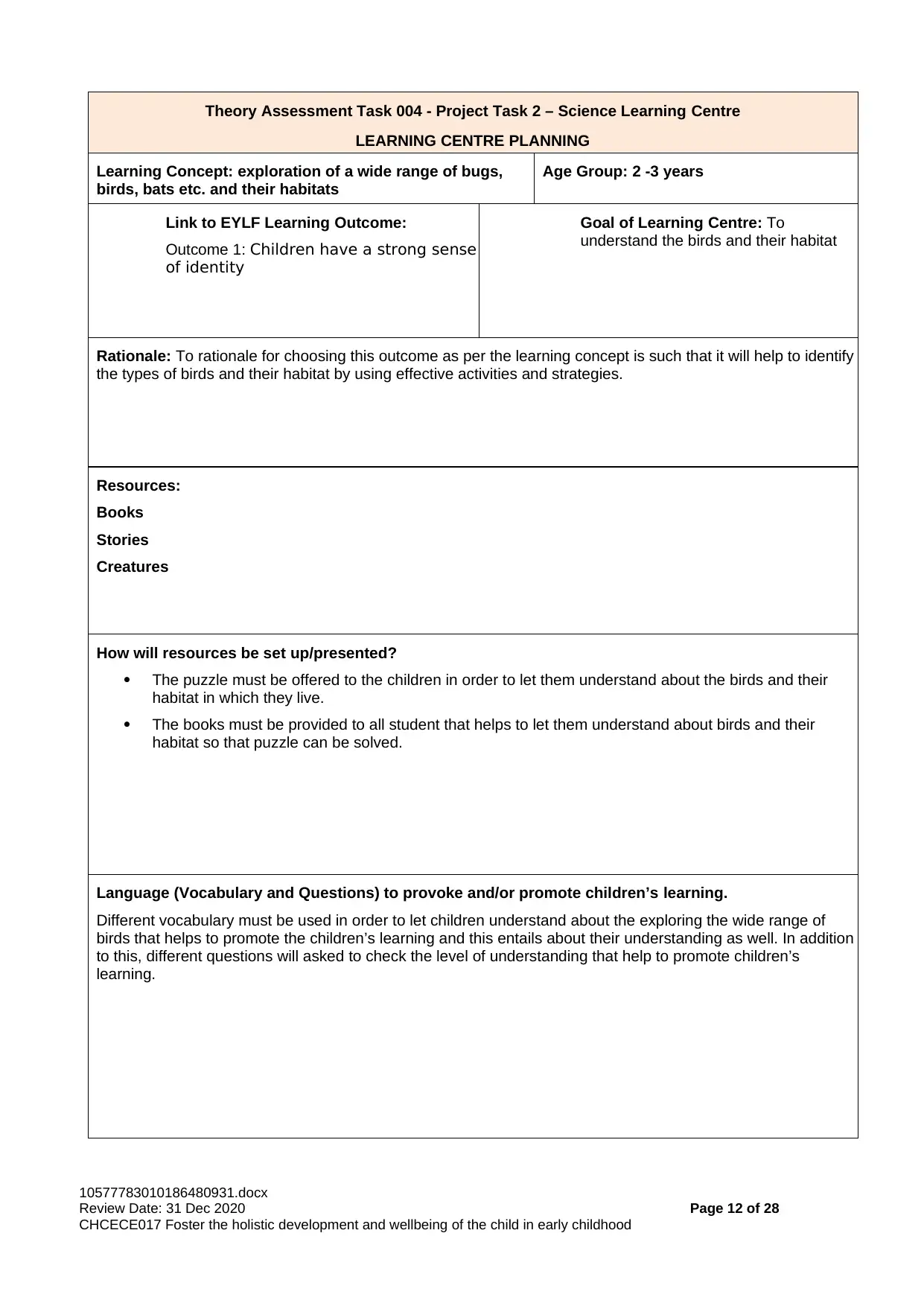
Theory Assessment Task 004 - Project Task 2 – Science Learning Centre
LEARNING CENTRE PLANNING
Learning Concept: exploration of a wide range of bugs,
birds, bats etc. and their habitats
Age Group: 2 -3 years
Link to EYLF Learning Outcome:
Outcome 1: Children have a strong sense
of identity
Goal of Learning Centre: To
understand the birds and their habitat
Rationale: To rationale for choosing this outcome as per the learning concept is such that it will help to identify
the types of birds and their habitat by using effective activities and strategies.
Resources:
Books
Stories
Creatures
How will resources be set up/presented?
The puzzle must be offered to the children in order to let them understand about the birds and their
habitat in which they live.
The books must be provided to all student that helps to let them understand about birds and their
habitat so that puzzle can be solved.
Language (Vocabulary and Questions) to provoke and/or promote children’s learning.
Different vocabulary must be used in order to let children understand about the exploring the wide range of
birds that helps to promote the children’s learning and this entails about their understanding as well. In addition
to this, different questions will asked to check the level of understanding that help to promote children’s
learning.
10577783010186480931.docx
Review Date: 31 Dec 2020 Page 12 of 28
CHCECE017 Foster the holistic development and wellbeing of the child in early childhood
LEARNING CENTRE PLANNING
Learning Concept: exploration of a wide range of bugs,
birds, bats etc. and their habitats
Age Group: 2 -3 years
Link to EYLF Learning Outcome:
Outcome 1: Children have a strong sense
of identity
Goal of Learning Centre: To
understand the birds and their habitat
Rationale: To rationale for choosing this outcome as per the learning concept is such that it will help to identify
the types of birds and their habitat by using effective activities and strategies.
Resources:
Books
Stories
Creatures
How will resources be set up/presented?
The puzzle must be offered to the children in order to let them understand about the birds and their
habitat in which they live.
The books must be provided to all student that helps to let them understand about birds and their
habitat so that puzzle can be solved.
Language (Vocabulary and Questions) to provoke and/or promote children’s learning.
Different vocabulary must be used in order to let children understand about the exploring the wide range of
birds that helps to promote the children’s learning and this entails about their understanding as well. In addition
to this, different questions will asked to check the level of understanding that help to promote children’s
learning.
10577783010186480931.docx
Review Date: 31 Dec 2020 Page 12 of 28
CHCECE017 Foster the holistic development and wellbeing of the child in early childhood
⊘ This is a preview!⊘
Do you want full access?
Subscribe today to unlock all pages.

Trusted by 1+ million students worldwide
1 out of 28
Related Documents
Your All-in-One AI-Powered Toolkit for Academic Success.
+13062052269
info@desklib.com
Available 24*7 on WhatsApp / Email
![[object Object]](/_next/static/media/star-bottom.7253800d.svg)
Unlock your academic potential
Copyright © 2020–2025 A2Z Services. All Rights Reserved. Developed and managed by ZUCOL.




